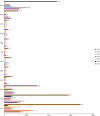Six-Year Study on Cutaneous Leishmaniasis in Al-Muthanna, Iraq: Molecular Identification Using ITS1 Gene Sequencing
- PMID: 38403879
- PMCID: PMC11224042
- DOI: 10.3947/ic.2023.0073
Six-Year Study on Cutaneous Leishmaniasis in Al-Muthanna, Iraq: Molecular Identification Using ITS1 Gene Sequencing
Abstract
Background: The current study aimed to determine the prevalence of cutaneous leishmaniasis (CL) in Al-Muthanna province (Iraq) and to characterize the Leishmania species that cause cutaneous lesions through conventional polymerase chain reaction techniques in some patients during the first 7 months of the year 2020.
Materials and methods: Medical information on patients with CL was obtained from archived records at the Al-Muthanna Health Office's Public Health Department (2015-2020). In the Al-Hussein Teaching Hospital laboratory, 95 CL samples were collected and examined microscopically for molecular characterization using Giemsa staining.
Results: Between 2015 and 2020, 2,325 patients (1,184 men and 1,141 women) were enrolled. Although CL occurred across all age groups, those aged range of 5-14 years had the highest proportion of infections (53.0%). This study found that most infections occurred between December and February, peaking in January. Only 63 of 95 CL samples were positive for the Internal Transcribed Spacer 1 region. L. tropica was found in 39 samples (61.9%), whereas L. major was found in 24 samples (38.1%), in CL patients. Although dermal lesions develop in all body regions, a single lesion is the most common. The upper limbs (13 of 16 samples, 33.3%)were infected with L. tropica, whereas the lower limbs (9 of 14 samples, 37.5%) were infected with L. major. In contrast to L. major, most L. tropica lesions occur in urban areas.
Conclusion: Our study indicates that CL is endemic in the Al-Muthanna province and that two Leishmania spp. coexist in the province. Molecular diagnosis is a vital component in determining many clinical symptoms of the Leishmania parasite as well as implementing suitable therapeutic, epidemiological, and control strategies.
Keywords: Baghdad boil; Dermal lesion; Internal Transcribed Spacer 1; Leishmania major; Leishmania tropica.
© 2024 by The Korean Society of Infectious Diseases, Korean Society for Antimicrobial Therapy, The Korean Society for AIDS, and Korean Society of Pediatric Infectious Diseases.
Conflict of interest statement
No conflict of interest.
Figures



Comment in
-
Response to Six-Year Study on Cutaneous Leishmaniasis in Al-Muthanna, Iraq: Molecular Identification Using ITS1 Gene Sequencing.Infect Chemother. 2024 Sep;56(3):411-412. doi: 10.3947/ic.2024.0051. Epub 2024 Jul 16. Infect Chemother. 2024. PMID: 39098005 Free PMC article. No abstract available.
Similar articles
-
Molecular Characterization of Leishmania Species among Patients with Cutaneous Leishmaniasis in Asir Province, Saudi Arabia.Pathogens. 2022 Dec 5;11(12):1472. doi: 10.3390/pathogens11121472. Pathogens. 2022. PMID: 36558806 Free PMC article.
-
Molecular identification of Leishmania tropica and L. infantum isolated from cutaneous human leishmaniasis samples in central Morocco.J Vector Borne Dis. 2020 Jan-Mar;57(1):71-77. doi: 10.4103/0972-9062.308804. J Vector Borne Dis. 2020. PMID: 33818459
-
Possible introduction of Leishmania tropica to urban areas determined by epidemiological and clinical profiles of patients with cutaneous leishmaniasis in Casablanca (Morocco).Parasite Epidemiol Control. 2020 Jan 3;9:e00129. doi: 10.1016/j.parepi.2019.e00129. eCollection 2020 May. Parasite Epidemiol Control. 2020. PMID: 32322694 Free PMC article.
-
Genetic diversity of Leishmania tropica strains isolated from clinical forms of cutaneous leishmaniasis in rural districts of Herat province, Western Afghanistan, based on ITS1-rDNA.Infect Genet Evol. 2016 Jul;41:120-127. doi: 10.1016/j.meegid.2016.03.031. Epub 2016 Apr 5. Infect Genet Evol. 2016. PMID: 27063410
-
Phylogenetic analysis of kinetoplast DNA: kDNA of Leishmania tropica in Thi-Qar province, Iraq.Comp Immunol Microbiol Infect Dis. 2021 Oct;78:101696. doi: 10.1016/j.cimid.2021.101696. Epub 2021 Aug 12. Comp Immunol Microbiol Infect Dis. 2021. PMID: 34416483 Review.
Cited by
-
Response to Six-Year Study on Cutaneous Leishmaniasis in Al-Muthanna, Iraq: Molecular Identification Using ITS1 Gene Sequencing.Infect Chemother. 2024 Sep;56(3):411-412. doi: 10.3947/ic.2024.0051. Epub 2024 Jul 16. Infect Chemother. 2024. PMID: 39098005 Free PMC article. No abstract available.
References
-
- Al-Warid HS, Al-Saqur IM, Al-Tuwaijari SB. ALZadawi KAM. The distribution of cutaneous leishmaniasis in Iraq: demographic and climate aspects. Asian Biomed. 2017;11:255–260.
LinkOut - more resources
Full Text Sources
Miscellaneous

